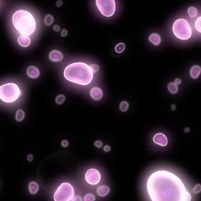Researchers Turn Up Brightness

Researchers from Carnegie Mellon University's Molecular Biosensor and Imaging Center (MBIC) are turning up the brightness on a group of fluorescent probes called fluoromodules — used to monitor biological activities of individual proteins in real-time.
The new fluoromodules glow much brighter than typical fluorscent proteins — a development that will open new avenues for research, including cancer research.
"This technology enhances the signal output for fluorescence imaging by nearly a factor of 10, and we've seen no evidence that this is the limit. This paves the way for simple, sensitive detection of single molecules in complex tissues, which may be used in next-generation diagnostics and interventional treatments to identify, classify or target tumors," said Marcel Bruchez associate research professor of chemistry and MBIC program director.
"In addition, these probes will enhance our basic understanding of biological pathways in tissues and other complex environments," he said. "As an example, we are working to detect changes that occur in a living animal's brain in response to a stimulus."
In a paper published online in the Journal of the American Chemical Society, MBIC researchers unveil a new class of dendron-based fluorogenic dyes called "dyedrons" that amplify the signal emitted by their fluoromodules.
"By using concepts borrowed from chemistry — the same concepts used in things like quantum dots and light harvesting solar cells — we were able to create a structure that acts like an antenna, intensifying the fluorescence of the entire fluoromodule," said Bruchez.
MBIC's fluoromodules are made up of a dye called a fluorogen and a fluorogen-activating protein (FAP). The FAP is genetically expressed in a cell and linked to a protein of interest, where it remains dark until it comes into contact with its associated fluorogen. When the protein and dye bind, the complex emits a fluorescent glow, allowing researchers to easily track the protein on the cell surface and within living cells.
Fluoromodules are unique in that they do not need to be washed off for specific labeling, they come in a spectrum of colors, and they are more photostable than other fluorescent proteins.
The MBIC researchers are currently using fluoromodules to study proteins on the cell surface, and hope to take the technology inside of cells in the near future. Additionally, they will be creating dyedrons for their other existing FAP/dye complexes.
This research was funded by the National Institutes of Health (NIH) as part of the American Reinvestment and Recovery Act. MBIC is one of the NIH's National Technology Centers for Networks and Pathways.
Related Links: MBIC | Dept of Chemistry
